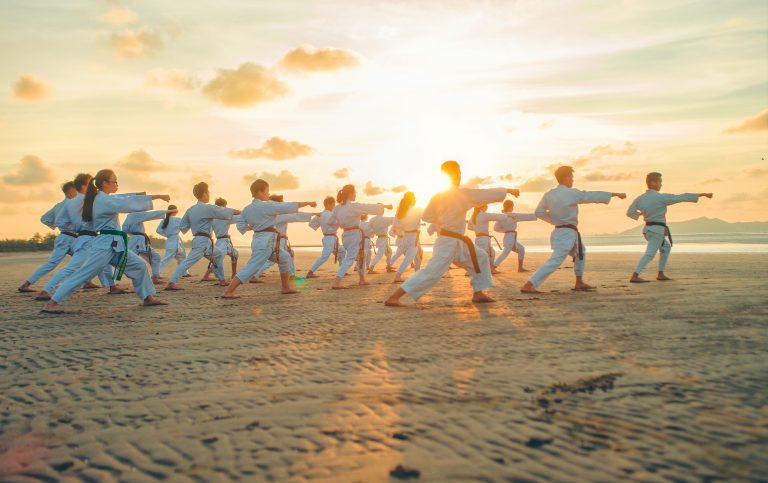Karate Rules: Understanding the Fundamentals of this Martial Art
Karate is a popular form of martial art that has gained immense popularity in recent years. It is a combat sport that requires a great deal of discipline, skill, and focus to master. Every karate practitioner must adhere to strict rules and regulations to ensure fair and safe competition. In this blog post, we will discuss the fundamental karate rules to help you understand this martial art better.
What is Karate?
Before we dive into the rules of karate, let us first understand what karate is. Karate is a martial art that originated in Okinawa, Japan, during the Ryukyu Kingdom period. It is a form of unarmed combat that involves striking, kicking, knee strikes, and punching techniques. Karate practitioners also use blocking and grappling moves to defend themselves against opponents.
The Basic Karate Rules
There are several rules that karate practitioners must follow to ensure fair and safe competition. Here are the basic karate rules:
1. Respect for opponents and instructors
In karate, all opponents and instructors must be treated with respect. This includes bowing before and after a match, using correct language to address them and showing good sportsmanship throughout the match.
2. Protective gear
Every karate practitioner must wear appropriate protective gear during competition. This includes a mouthguard, hand and foot protectors, and a groin cup (for male participants). Protective gear ensures the safety of the participants during competition.
3. Scoring system
Karate matches are scored based on the opponent’s technique, spirit, and attitude. Points are awarded for successful punches, kicks, knee strikes, and blocks. The opponent with the highest score at the end of the match is declared the winner.
4. Time limit
Karate matches are typically three minutes long, with a one-minute rest in between rounds. In case of a tie, another round is played until a winner is declared.
5. Fouls
Several moves are considered fouls in karate, including attacking private parts, attacking the spine or neck, and unsportsmanlike conduct. If a participant commits a foul, they will be penalized, and points will be deducted.
Types of Karate Matches
Karate matches can be classified into two main categories:
Kata Matches
Kata is a form of karate that involves practicing solo movements and techniques. In a kata match, participants are judged based on their technique, form, speed, power, and rhythm. The judges award points based on these aspects, and the participant with the highest score wins.
Kumite Matches
Kumite is a form of karate that involves sparring with an opponent. Participants in a kumite match are awarded points for successful techniques landed on their opponent. Kumite matches are further classified into two categories:
- Individual Kumite: This involves a one-on-one match between two participants.
- Team Kumite: This involves teams of three or five participants who take turns fighting members of the opposing team.
Most Frequently Asked Questions About Karate Rules
Karate has its own unique set of rules and regulations, which can be overwhelming for both beginners and experienced practitioners. In this blog post, we’ll answer some of the most frequently asked questions about karate rules to provide you with a better understanding of the sport.
Q: What are the basic rules of karate?
A: The basic rules of karate include the use of both hands and feet to strike the opponent’s target areas, known as „vital points.“ The goal is to accumulate points by delivering clean and controlled strikes to these areas while avoiding attacks from your opponent. Strikes can be delivered with both open and closed hands, as well as kicks to the legs, torso, and head.
Q: What is the scoring system in karate?
A: Karate matches are generally scored using a system of „yuko,“ „waza-ari,“ and „ippon.“ Each scoring level requires different levels of technique and accuracy. „Yuko“ is the lowest scoring level, awarded for strikes that land cleanly but without much force. „Waza-ari“ is the middle level of scoring, awarded for strikes that are more forceful and accurate than Yuko. „Ippon“ is the highest level of scoring and is awarded for strikes that are both powerful and precise.
Q: What are some of the prohibited techniques in karate?
A: Some of the techniques that are prohibited in karate include any strike to the back of the head or neck, any attack to the opponent while they are down, and any technique that involves grabbing or holding the opponent’s uniform. These techniques are not only against the rules but can also be dangerous and cause serious injury.
Q: Is there a time limit for karate matches?
A: Yes, karate matches typically last for three minutes, with a one-minute break in between rounds. If there is a tie at the end of the match, an additional one-minute overtime round is added. If the score is still tied after the overtime round, the winner is determined based on the number of warnings each player received.
Q: Are there weight classes in karate?
A: Yes, karate competitions are generally divided into weight classes, with participants grouped based on their weight. This helps to ensure that matches are fair and safe, with participants of similar sizes competing against each other.
Q: Do different karate styles have different rules?
A: Yes, different karate styles may have different rules and regulations, although the basic principles and techniques are usually the same. It’s important to familiarize yourself with the rules of the specific style you’re practicing or competing in to avoid any confusion or penalties.
Q: What is the penalty for breaking the rules in karate?
A: Penalties in karate may include deductions in points, disqualification, or even suspension from future competitions. It’s important to follow the rules and regulations to ensure fair and safe matches for all participants.
In conclusion, understanding the rules and regulations of karate is essential for both beginners and experienced practitioners. Take the time to familiarize yourself with the rules and regulations of the specific style you’re practicing or competing in to avoid any confusion or penalties. By following the rules, you’ll be able to engage in safe and fair matches, improve your skills, and enjoy the many benefits of practicing karate.
Karate Rules – A Guide For Beginners
Karate is a popular martial art that originated from Japan. It is known for its intense training and discipline, and is practiced all over the world. However, before you start training, it is important to understand the rules and regulations of the sport. In this article, we will provide you with a comprehensive guide on karate rules that you need to know.
What is Karate?
Karate is a form of martial art that originated in Japan in the early 20th century. It is a sport that involves various techniques such as punching, kicking, knee strikes, elbow strikes, and open-hand techniques. The objective of karate is to strike the opponent with these techniques and score points.
The Basic Rules of Karate
The following are the basic rules of karate:
1. Scoring
In karate, scoring is based on the number of clean techniques you land on your opponent. Clean techniques mean striking the opponent with control and precision. Points are awarded for strikes to the head, neck, and torso, with different point values for different techniques.
2. Time Limits
Karate matches are typically three to five minutes long, with one minute of rest between rounds. In the case of a tie, the match will go into extra time until a winner is determined.
3. Illegal Techniques
Certain techniques are not allowed in karate competitions, including:
- Striking with the fist to the face or head
- Attacking the opponent while they are down
- Grabbing or twisting the opponent’s joints or limbs
- Intentionally striking the opponent with the knee, elbow, or heel
- Using excessive force
4. Protective Gear
In order to ensure the safety of the participants, all karate fighters are required to wear protective gear during competition. This typically includes:
- A mouthguard to protect the teeth and gums
- A groin protector for male participants
- A chest protector for female participants
- A helmet to protect the head and face
- Hand and foot padding to protect from impact
Karate Scoring System
Karate matches are scored by the following points system:
- 1 point – Yuko
- 2 points – Waza-ari
- 3 points – Ippon
A Yuko is awarded for a clean technique that lands on the opponent’s side or back. A Waza-ari is awarded for a more impactful strike that lands on the opponent’s side or back. An Ippon is awarded for a clean technique that lands on the opponent’s head, neck, or torso with significant impact. An Ippon can also be awarded for a throw that results in the opponent being unable to continue.
Conclusion
Karate is an exciting martial art that requires discipline and focus. The rules of karate are designed to ensure the safety of the participants while still allowing for intense competition. Understanding these rules is crucial for anyone who wishes to compete in karate. With this guide, you should now have a basic understanding of the karate rules and scoring system to get you started.
Inhaltsverzeichnis






